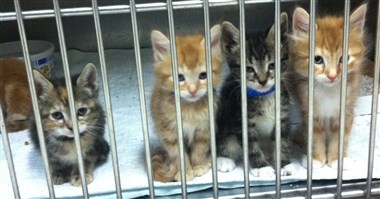
and experiences.
Dear HVHS Friends,
We are swamped with calls from potential adopters seeking kittens and we thought this would be a good time to post some kitten basics…
AGE: Kittens are aged based on their body weight. One pound of body weight is equivalent to one month of life. Therefore a 1.5# kitten is approximately 6 weeks of age; 2# is approximately 8 weeks, etc.
VACCINE ELIGIBILITY: Kittens should receive a series of 3 “combination vaccines” approximately 3 weeks apart beginning at 5-6 weeks.
RABIES VACCINE: Kittens are eligible for a valid rabies vaccine at the age of 3 months or 3# of body weight. In the absence of knowing their true date of birth, body weight is the guide. If a kitten’s DOB is known and their body weight is less than 3# the kitten could be given this vaccine although it will be necessary to administer a booster once the kitten exceeds 3#. Rabies can, to quote a trusted veterinarian, “pop up at any time” therefore the HVHS will not adopt an animal into the general population without a valid rabies vaccine. This is in the best interest of the animal and the community, there are no exceptions.
FIV/AIDS/LEUKEMIA: In order to have valid test results, veterinarians recommend testing at 3# of body weight. Testing too soon can give what is known as a false positive or false negative and at the HVHS we want to be sure of their status. As a result, we test at 3#.
SPAYING/NEUTERING: 3# is the magic minimum weight at which time we prefer to spay and neuter. Why? For males it is an external surgery and usually by this age their testicles have dropped and the surgery is quick and safe. For females spaying is major surgery and at 3# their uterus is more mature. Spaying younger females makes the surgery more difficult on the veterinarian because the uterus can shred during the procedure. That also makes the time under anesthesia longer and we choose to prevent that.
CHUBBY BELLY: While this is cute, that round chubby belly is indicative of intestinal parasites. At the HVHS we de-worm every 21 days which aligns with the lifecycle of intestinal parasites and often needs repeating after going home. We treat with Panacur, Albon and Nemex as standard procedure.
EAR GUNK: Nobody has ever said “how cute there’s gunk in my kitten’s ears!” That gunk is usually due to ear mites which are common, and we treat accordingly to eliminate the problem.
MICROCHIP: At the HVHS all our “kids” leave with a microchip implanted and it comes with a lifetime registration.
FLEAS/FLEA DIRT/TICKS: All HVHS felines are treated appropriately to eliminate and prevent fleas and ticks.
COAT COLORATION: Kittens come in all colors, but did you know that some colors are tied to gender? Yes it’s true. Orange cats are generally males (think Morris the cat); only 1 of every 27 orange cats will be female. Tri-colored cats are referred to as ‘calico’ they will have black, white and orange coats. They can also be ‘dilute calico’ which is gray, white and cream or white. These tri-colored beauties are genetically female and only 1 in 2,000 will be male. At the HVHS we actually had a male calico a few years ago.
Congratulations! You have just completed the HVHS Kitten 101 Basic Course. We hope to see you this spring and help you adopt a healthy feline. Kitten 102 Advanced Basic will be posted soon, stay tuned.


